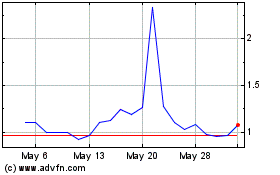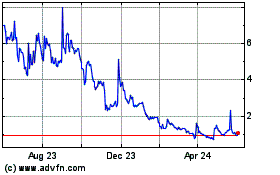July 2, 2024
Biodexa Pharmaceuticals PLC
Positive Phase 1 Clinical Data of MTX110
in DMG Brain Cancer Demonstrating Increased Survival Presented at
ISPNO 2024
After Only Two Infusions and Two Patients
at Optimal Dose, Median Overall Survival Across
all Patients was 16.5 Months (vs 10.0 Months in
Historical Reference Cohort)
(DATELINE) JULY 2 -- Biodexa
Pharmaceuticals PLC (“Biodexa” or the “Company”) (Nasdaq: BDRX), an
acquisition-focused clinical stage biopharmaceutical company
developing a pipeline of innovative products for the treatment of
diseases with unmet medical needs, announces data from a Phase 1
study of MTX110 in Diffuse Midline Glioma (“DMG”) f/k/a Diffuse
Intrinsic Pontine Glioma, or DIPG, an orphan pediatric brain cancer
were presented over the weekend at the 21st International Symposium
on Pediatric Neuro-Oncology (ISPNO 2024) in Philadelphia, PA.
Results of the Phase 1
studyOverall, the treatment was well tolerated by
patients. There was one Grade 4 adverse event assessed by the
investigators as unrelated to the drug but related to the infusion
and tumor anatomy. Most other adverse events were related to
infusion and were deemed Grade 2 to 3.
Although the study was not powered to reliably
demonstrate efficacy, median progression free survival (PFS) was 10
months (range 8 to 20 months) and overall survival (OS) of patients
in the study was 16.5 months (range 12 to 35 months). This compares
favourably with median OS in a cohort of 316 cases of 10.0 months
(Jansen et al, 2015. Neuro-Oncology 17(1):160-166).
Design of the Phase 1 studyThe
open label investigator-initiated study was conducted by Columbia
University Irving Medical Center in patients newly diagnosed with
DMG. Patients were administered MTX110 via convection enhanced
delivery (“CED”) using a subcutaneous pump connected to a catheter
directly implanted into the pons in a 3+3 dose-escalating design
(NCT 04264143).
As this was the first ever study of repeated
infusions to the pons via an implanted CED catheter, the primary
endpoint of the study was to evaluate the safety and maximum
tolerated dose with secondary endpoints of Progression Free
Survival and Overall Survival.
The number of infusions was limited to two, each
of 48 hours, seven days apart. Nine patients were treated in the
study (30 M group, n=3; 60 M group, n=4; 90 M group (optimal dose),
n=2). Although the study was not powered to reliably demonstrate
efficacy, median overall survival (OS) of patients in the study was
16.5 months. This compares favourably with median survival rate in
a cohort of 316 cases of 10.0 months (Jansen et al, 2015.
Neuro-Oncology 17(1):160-166).
MTX110 in DMGIn October 2020,
the Company announced headline results from a Phase I study at the
University of California, San Francisco (“UCSF”) in patients with
DMG (the “UCSF study” NCT03566199).
The primary endpoint of the study was to
determine the dosage regimen to be used in a proposed Phase II
study of the safety and efficacy of MTX110 in patients with DIPG.
Preliminary high-level data from the UCSF study supports a dose of
between 60μM and 90μM of MTX110, depending upon patient tolerance
over the course of 12 infusions in Phase II.
In total, seven patients were recruited into the
UCSF study. Patients were newly diagnosed with DMG and received
focal external beam radiation therapy four to 14 weeks before
commencement of MTX110 treatment. MTX110 was administered directly
into the tumour via a micro-catheter using CED with
gadolinium-enhanced intra-operative MRI to guide and track drug
distribution to the tumour. Patients could receive up to 12 cycles
of treatment every four to eight weeks. The dose was escalated
between and within patients as tolerated initially by increasing
the infusion volume at a concentration of 30μM MTX110 and then with
higher drug concentrations of 60μM and 90μM as the sixth and
seventh dose increments, respectively.
Median overall survival based on Kaplan Meier
analysis was 26.06 months. Survival was not an endpoint of the UCSF
study nor was the study powered for statistical significance.
About MTX110MTX110 is a
water-soluble form of panobinostat free base, achieved through
complexation with hydroxypropyl-β-cyclodextrin (HPBCD), that
enables CED at potentially chemotherapeutic doses directly to the
site of the tumour. Panobinostat is a hydroxamic acid and acts as a
non-selective histone deacetylase inhibitor (pan-HDAC inhibitor).
The currently available oral formulation of panobinostat lactate
(Farydak®) is not suitable for treatment of brain cancers owing to
poor blood-brain barrier penetration and inadequate brain drug
concentrations. Based on favourable translational science data,
MTX110 is being evaluated clinically as a treatment for DMG
(NCT03566199, NCT04264143) and recurrent medulloblastoma
(NCT04315064), and recurrent glioblastoma (NCT 05324501). MTX110 is
delivered directly into and around the patient’s tumor via a
catheter system (e.g. CED or fourth ventricle infusions) to bypass
the blood-brain barrier. This technique exposes the tumor to very
high drug concentrations while simultaneously minimising systemic
drug levels and the potential for toxicity and other side effects.
Panobinostat has demonstrated high potency against DMG tumor cells
in in vitro and in vivo models, and in a key study it was the most
promising of 83 anticancer agents tested in 14 patient-derived DMG
cell lines (Grasso et al, 2015. Nature Medicine 21(6),
555-559).
For more information, please contact:
|
Biodexa Pharmaceuticals PLC |
|
Stephen Stamp, CEO, CFOTel: +44 (0)29 20480
180www.biodexapharma.com |
About Biodexa Pharmaceuticals PLC
Biodexa Pharmaceuticals PLC (listed on NASDAQ:
BDRX) is a clinical stage biopharmaceutical company developing a
pipeline of innovative products for the treatment of diseases with
unmet medical needs. The Company’s lead development programs
include eRapa, under development for Familial Adenomatous Polyposis
and Non-Muscle Invasive Blader Cancer: tolimidone, under
development as a for the treatment of type 1 diabetes; and MTX110,
which is being studied in aggressive rare/orphan brain cancer
indications.
eRapa is a proprietary oral tablet formulation
of rapamycin, also known as sirolimus. Rapamycin is an mTOR
(mammalian Target Of Rapamycin) inhibitor. mTOR has been shown to
have a significant role in the signalling pathway that regulates
cellular metabolism, growth and proliferation and is activated
during tumorgenesis.
Tolimidone is an orally delivered, potent and
selective inhibitor of Lyn kinase. Lyn is a member of the Src
family of protein tyrosine kinases, which is mainly expressed in
hematopoietic cells, in neural tissues, liver, and adipose tissue.
Tolimidone demonstrates glycemic control via insulin sensitization
in animal models of diabetes and has the potential to become a
first in class blood glucose modulating agent.
MTX110 is a solubilised formulation of the
histone deacetylase (HDAC) inhibitor, panobinostat. This
proprietary formulation enables delivery of the product via
convection-enhanced delivery (CED) at chemotherapeutic doses
directly to the site of the tumor, by-passing the blood-brain
barrier and potentially avoiding systemic toxicity.
Biodexa is supported by three proprietary drug
delivery technologies focused on improving the bio-delivery and
bio-distribution of medicines. Biodexa’s headquarters and R&D
facility is in Cardiff, UK. For more information visit
www.biodexapharma.com.
Forward-Looking
Statements
Certain statements in this announcement may
constitute “forward-looking statements” within the meaning of
legislation in the United Kingdom and/or United States. Such
statements are made pursuant to the safe harbor provisions of the
Private Securities Litigation Reform Act of 1995 and are based on
management’s belief or interpretation. All statements contained in
this announcement that do not relate to matters of historical fact
should be considered forward-looking statements. In certain cases,
forward-looking statements can be identified by the use of words
such as “plans”, “expects” or “does not anticipate”, or “believes”,
or variations of such words and phrases or statements that certain
actions, events or results “may”, “could”, “would”, “might” or
“will be taken”, “occur” or “be achieved.” Forward-looking
statements and information are subject to various known and unknown
risks and uncertainties, many of which are beyond the ability of
the Company to control or predict, that may cause their actual
results, performance or achievements to be materially different
from those expressed or implied thereby, and are developed based on
assumptions about such risks, uncertainties and other factors set
out herein.
Reference should be made to those documents that
Biodexa shall file from time to time or announcements that may be
made by Biodexa in accordance with the rules and regulations
promulgated by the SEC, which contain and identify other important
factors that could cause actual results to differ materially from
those contained in any projections or forward-looking statements.
These forward-looking statements speak only as of the date of this
announcement. All subsequent written and oral forward-looking
statements by or concerning Biodexa are expressly qualified in
their entirety by the cautionary statements above. Except as may be
required under relevant laws in the United States, Biodexa does not
undertake any obligation to publicly update or revise any
forward-looking statements because of new information, future
events or events otherwise arising.
Biodexa Pharmaceuticals (NASDAQ:BDRX)
Historical Stock Chart
From Dec 2024 to Jan 2025

Biodexa Pharmaceuticals (NASDAQ:BDRX)
Historical Stock Chart
From Jan 2024 to Jan 2025
